#GnomeHistory
Explore tagged Tumblr posts
Text
Gnomelands.com
In my search for the entire Grasslands gnome collection I found this awesome website!

They are so right about it being a happy place!

I would love to have one of these original garden gnomes!

They have a book entitled “gnomeland and introduction to the little people” available at their shop!

You can also get it at amazon! They have a short introduction to gnomes too!


They have various types of gnome art too!




You should really go check out the website!
http://gnomelands.com/
I am very thankful for them!
#gnomes#gardengnomes#gnomelove#gnomegirlgabby#gnomeWebsite#Gnomelands.com#TraditionalGnomes#GnomeHistory#GnomeArt#gnomesThings
6 notes
·
View notes
Text
Wiki Garden Gnome
Wiki Garden Gnome Article <3 Thanks Wiki
Garden gnome
Garden gnomes (German: Gartenzwerge, lit. 'garden dwarfs') are lawn ornament figurines of small humanoid creatures known as gnomes. Traditionally, the figurines depict male dwarfs wearing red pointy hats. Typically, gnomes stand between one and two feet (30 and 60 cm). A recent[when?] trend has introduced miniature gnomes of only a few inches in height. Originating as a decoration for the wealthy in Europe, garden gnomes are now prevalent in gardens and lawns throughout the western world, among all social classes, and often regarded as kitsch.
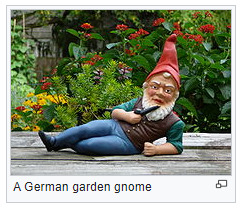
Gnomes
History
In ancient Rome, small stone statues depicting the Greco-Roman fertility god Priapus, also the protector of floors, were frequently placed in Roman gardens. Gnomes as magical creatures were first described during the Renaissance period by Swiss alchemist Paracelsus as "diminutive figures two spans in height who did not like to mix with humans". During this period, stone "grotesques", which were typically garishly painted, 1-metre-tall (3.3 ft) figurines, were commonly placed in the gardens of the wealthy. Among the figures depicted were gobbi (Italian for hunchbacks). In particular, Jacques Callot produced 21 versions of gobbi, which he engraved and printed in 1616.
Pre-twentieth century
By the late 1700s, gnome-like statues made of wood or porcelain called "gnomes" became popular household decorations. The area surrounding town of Brienz in Switzerland was known for their production of wooden house dwarfs. In Germany, these garden figurines became conflated with their traditional stories and superstitions about the "little folk" or dwarfs that they believed helped around the mines and on the farm. The Dresden company Baehr and Maresch had small ceramic statues of dwarfs or "little folk" in stock as early as 1841, and although the claim has been contested, some credit Baehr and Maresch with the first garden dwarfs (German: Gartenzwerge)

Within less than 10 years, statues of dwarfs had spread from the provinces of Saxony and Thuringia across Germany to France and, in 1847, Sir Charles Isham, brought 21 terracotta gnomes manufactured in Germany by Philip Griebel back to Britain where they were called "gnomes" in English and placed in the gardens of Isham's home, Lamport Hall in Northamptonshire. Nicknamed "Lampy", the only gnome of the original batch to survive is on display at Lamport Hall and insured for GB£1 million.
The manufacture of gnomes spread across Germany, with numerous other large and small manufacturers coming in and out of the business, each having its own particular style of design. From around 1860 onwards, many statues were made in Gräfenroda, a town in Thuringia known for its ceramics.
Garden gnomes spread to other countries in Europe in the 1840s and became particularly popular in France and Britain The term "garden gnome" may originate from the term "Gnomen-Figuren" (miniature figurines), used in the original German catalogues.
Twentieth century
Garden gnomes were further popularized when Sir Frank Crisp, the owner of the second largest collection of garden gnomes in the UK opened his Friar Park, Henley-on-Thames estate to the public at least once a week from 1910-1919. It was here where garden enthusiasts and visitors from around the world perhaps saw garden gnomes for the first time.
The reputation of German gnomes declined after World War I, but they became popular again in the 1930s following Disney's animated film Snow White and the Seven Dwarfs, when more working-class people were able to purchase them. Tom Major-Ball (father of former British prime minister John Major) was the most notable producer at that time with his company Major's Garden Ornaments.World War II and the years following were also hard on the industry, and most producers gave it up then.
Garden gnomes saw a resurgence in popularity again in the 1970s with the creation of more humorous types of gnomes. In the 1990s travelling gnome and garden gnome pranks became popular and made national news at times, where people steal a garden gnome from an unknowing person's lawn and then send the owner photos of the gnome as a practical joke before returning it.
Twenty-first century
Philip Griebel's descendants are still producing garden gnomes in Germany. As of 2008, there were an estimated 25 million garden gnomes in Germany.
Types of garden gnomes
Garden gnomes are typically male, often bearded, usually wear red phrygian caps and often have pipes. They are often shown pursuing leisurely pastimes such as fishing or napping.
Gnomes may be made from terracotta clay slip (runny clay) poured into molds. This is allowed to set up and the excess emptied from the centre, leaving a clay shell. The gnome is removed from the mold when firm, allowed to dry and then fired in a kiln until hard. Once cooled, the gnome is painted. More modern gnomes are made from resins and similar materials.
Today, many different variations of garden gnomes exist, including humorous ones ranging from the lighthearted biker or barbecuing gnome, to the more dark, such as one stabbed in the back or wearing an executioner's hood.
In popular culture and politics
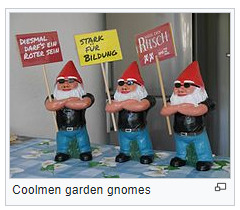
Gnomes have become controversial in serious gardening circles in the UK, and were for a time banned from the prestigious Chelsea Flower Show, as the organisers claimed that they detract from the garden designs.Gnome enthusiasts accused the organisers of snobbery, as garden gnomes are popular in the gardens of working class and suburban households. The ban was lifted during 2013 to mark the show's centenary.
In the Italian movie The Monster (1994), the main character Loris, played by Roberto Benigni, is rightfully accused of stealing the garden gnome Bashful.
A subplot in the 2001 French movie Amélie revolves around a "travelling" garden gnome.
A two-foot-tall (60 cm) garden gnome with a long, white beard, red conical hat and blue coat is the central figure in Travelocity's Roaming Gnome advertising campaign which was launched in January 2004.
Gnomeo and Juliet is a 2011 British-American CGI film that is inspired by the tragedy of Romeo and Juliet featuring garden gnomes as the characters. In 2018, its sequel, Sherlock Gnomes, was released.
The Social Democratic Party of Austria (SPÖ) used garden gnomes, which they called "Coolmen", in their campaign for the 2014 regional elections in Vorarlberg. It was intended as an ironic pun since the SPÖ historically performed poorly in elections in this part of Austria and considered itself to be a political "dwarf". The campaign placed 20,000 Coolmen holding small posters with short slogans along highly frequented roads. The party made a police report after 400 of them went missing, drawing attention from the international media.
The 2010 video game Fable III includes a side mission where a collection of garden gnomes are given magical properties, which the player character must collect throughout the world.
Garden gnomes feature as the driving motivator of Old Man Henderson, whose exploits derailed a Call of Cthulhu variant tabletop roleplaying game, described on the website 1d4chan in 2010. The character Henderson's sole motivation was to "rescue" roughly $40,000 worth of garden gnomes from a local cult, not realizing that he'd given them to charity before the game's starting session.
A 2005 episode of King of the Hill titled "Yard, She Blows!" revolves around Bobby breaking Peggy's newly acquired, and very rare, garden gnome. Hank, hating the gnome, attempts to use the event to eliminate it from the front lawn.
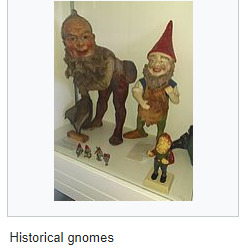
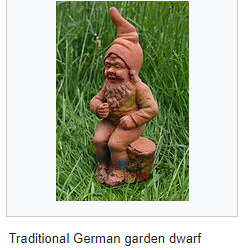
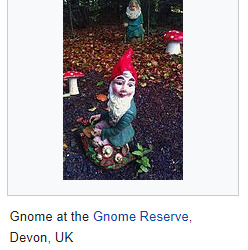
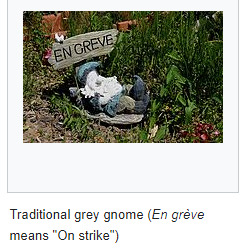
https://en.wikipedia.org/wiki/Garden_gnome
Thanks again Wiki! <3
3 notes
·
View notes
Text
DND Gnome History
So as the theme of the night is DND Gnomes might as well talk about their history in DND! Thank you Wiki for this!
In the Dungeons & Dragons fantasy role-playing game, gnomes are one of the core races available for play as player characters.[1] Some speculate that they are closely related to dwarves; however, gnomes are more tolerant of other races and of magic, and are skilled with illusions.[1] Gnomes are small humanoids, standing 3–3.5 feet (91–107 cm) tall.
Dungeons & Dragons
The gnome first appeared in the original 1974 edition of Dungeons & Dragons,[2] and in its second supplement, Blackmoor (1975).[3]
Advanced Dungeons & Dragons 1st edition
The gnome appeared as a player character race in the original Player's Handbook (1978).[4][5] The gnome also appeared in the original Monster Manual (1977).[6] A new gnomish subrace, the deep gnome (svirfneblin), was presented as a character race in the original Unearthed Arcana (1985).[7] Another gnome subrace, the tinker gnome (minoi), focused on building mechanical devices, was presented in Dragonlance Adventures. The humorous Solo Quest adventure Gnomes-100, Dragons-0 featured these gnomes in their resistance against the dragon army of Takhisis.[8]
Gnomes were originally introduced to Dungeons & Dragons as a new alternative to dwarves, elves, and halflings.[9][10] They were developed from mythology from a number of different sources, originally being a bearded, short race similar to halflings and dwarves. The gnome's niche in play was made magical, to separate it from the more warrior-like dwarf and the more rogue-like halfling.[11]
Dungeons & Dragons (Basic/BECMI)
The gnome appeared in the Dungeons & Dragons Basic Set as a "monster". The gnome appeared as a player character class in Top Ballista (1989).
Advanced Dungeons & Dragons 2nd edition
The gnome appeared as a character race in the second edition Player's Handbook (1989).[12] The gnome also appeared in the Monstrous Compendium Volume One (1989).[13] Four gnomish races – forest, rock, tinker, and deep (svirfneblin) – were detailed as player character races in The Complete Book of Gnomes and Halflings (1993).[14]
Dungeons & Dragons 3rd edition
The gnome appeared as a character race in the third edition Player's Handbook (2000),[15] and in the 3.5 revised Player's Handbook.[16] Gnomes were detailed for the Forgotten Realms setting in Races of Faerûn (2003).[17] Gnomes were one of the races detailed in Races of Stone (2004).
Throughout D&D history, up to and including the third edition Player's Handbook, spellcaster gnomes were either illusionists or had illusionist as their favored class.[18][19] However, in Dungeons & Dragons v.3.5, gnomes' favored class has been changed to bard, as the favored class of "illusionist" was a subset of the wizard class. The wizard favored class was also already used by elves. In D&D v.3.5, gnomes are inventors and alchemists who love pranks and excel at engineering. The tinker gnomes of Dragonlance are mechanically skilled, though their devices are quite prone to backfiring. It has been suggested that gnomes be given the Eberron class artificer as a favored class, due to their technical aptitude.
Dungeons & Dragons 4th edition
Gnomes appeared in 4th edition as a player character race in Player's Handbook 2 (2009).[20] The gnome appeared in the Monster Manual (2008).
Dungeons & Dragons 5th edition
The gnome was included as a player race in the 5th edition Player's Handbook (2014).[21] Two subraces were introduced with it: the forest gnome and the rock gnome. The Player's Handbook connects the rock gnomes to the tinker gnomes of the Dragonlance setting.
The deep gnome (svirfneblin) is also referenced in the Player's Handbook, and is fully detailed in the 5th edition Monster Manual (2014).[21][22] The Elemental Evil Player's Companion (2015) presents the deep gnome as a player race.[23]
Subraces
Gnomes in Dungeons & Dragons have been further divided into various subraces:
Rock gnomes are the standard gnome subrace of Third Edition. They live in burrows beneath rolling, wooded hills.
Tinker gnomes are the common gnomes of the Dragonlance campaign setting. In that fictional universe, they dwell in the Mount Nevermind in the world of Krynn.
Svirfneblin, or deep gnomes, dwell in cities deep underground. They are more dangerous than the common rock gnome.
Forest gnomes are smaller than rock gnomes. They are a shy, secretive folk, living deep in wooded areas.[24] Friends to animals, forest gnomes have a racial ability that allows them to speak with small animals.
River Gnomes are graceful and quick. They live in homes dug into the side of riverbanks and speak with river dwelling animals in place of burrowing mammals. They are non-magical but gain +1 to initiative and are proficient swimmers.
Arcane Gnomes are city dwellers. They generally keep to a small community within a larger city. Arcane gnomes are focused on the pursuit of knowledge making their populace, in large part, over-eager inventors or wizards.[25]
Chaos gnomes are the most flamboyant gnomes. Brightly colored and rare, they are strongly inclined towards chaos, as their name suggests.[26]
Whisper gnomes lack the jovial outlook of other gnome races. Sly and suspicious, they are creatures of stealth.[26]
Ice gnomes dwell in the region of Frostfell in the Eberron campaign setting
Fire gnomes live on Bytopia, on the Outer Planes, where they help Flandal Steelskin, the Gnomish god of metal and crafting, in his work.
Sky gnomes appear in the Creature Crucible Top Ballista PC2 published in 1989. They are cunning engineers living in the flying city Serraine above the World of Mystara.
In the Forgotten Realms campaign setting, gnomes are also known as the "Forgotten Folk".
Society
Gnome society had changed greatly over the different editions of Dungeons & Dragons. In the first edition, they were portrayed as intensely curious and intellectual, keeping in theme with their spell-casting niche, with an interest in gemstones.[18] They typically lived in hills, and acted as intermediaries between dwarves, elves, and halflings.
In the second edition, gnomes received further background. According to The Complete Book of Gnomes and Halflings,[27] gnomes have an intricate society based on their love of all kinds of arts, pranks, and their long lives. Their society is based on art; all gnomes must take up some form of art whether music, painting, cooking, building, or any other form that is considered creative by the time they come of age.
Gnomes are naturally friendly, highly social and fun loving people. They are respected by Elves for their communion with nature and knowledge of arcane magic, admired by Halflings for their humor, and sought out by Dwarves for their gemcutting skills.
Religion
Garl Glittergold was created by James M. Ward and first appeared in the "Nonhuman Deities" chapter of the original Deities and Demigods (1980) as the god of gnomes.[28]Roger E. Moore detailed several additional gnomish gods in his article "The Gods of the Gnomes" in Dragon #61 (May 1982), including: Baervan Wildwanderer, god of adventure and thieves; Urdlen ("The Crawler Below"), god of evil; Segojan Earthcaller, god of earth and nature; and Flandal Steelskin, god of metalworking;[29] these four newer gods also appeared in the original Unearthed Arcana (1985).[30]
All five of these deities were detailed for Advanced Dungeons & Dragons second edition in the book Monster Mythology (1992) by Carl Sargent, including details about their priesthoods; this book also introduced additional gods including: Baravar Cloakshadow, god of illusions, protection, and deception; Gaerdal Ironhand, god of protection, vigilance, and combat; and Nebelun (The Meddler), god of inventions and good luck.[31] All of these gods also received a very detailed description for their roles in the Forgotten Realms in Demihuman Deities (1998).[32]
Further reading
Tresca, Michael J. (November 2010). The Evolution of Fantasy Role-Playing Games. McFarland. pp. 34–36, 140–141. ISBN 978-0786458950.
Bowman, Sarah Lynne (May 2010). The Functions of Role-Playing Games. McFarland. pp. 151, 165–166. ISBN 978-0786447107.

So I hope you enjoyed the in depth DND knowledge about gnomes! Link to the gnome article below!
https://en.wikipedia.org/wiki/Gnome_(Dungeons_%26_Dragons)
4 notes
·
View notes
Text
House and Home Gnome Facts
Check out these gnome facts from House and home!

Thank you house and home!


My responses to these fun facts!
I had no idea they were found at the tops of barns that is so cool!
They are no longer banned from the Chelsea Flower Show that was overturned in 2013 but the article is from 2012
I call at-ease gnomes ChillinGnomes :)
I like to think gnomes will live much longer than that...
Clumsy humans or drunk humans are often culprits too...
That is false but they do wear them most often, green and blue are also popular and are distinct to their region of gnome or individuality!
I can’t believe his daughter got rid of the other twenty she is a cruel woman that hurts my soul deeply!
They still do this today and I will not lie to you all it turns me into a nervous wreck about my gnomes!
They really like jelly so make sure you stock up and strawberries too!
Gnome kisses are so cute! I love to get gnome kisses!
Welp that is all I have to say about that!
https://www.houseandhome.ie/news-events/fun-facts-10-things-you-need-know-about-garden-gnomes-1686
#GnomeArticle#GnomeFacts#GnomeHistory#gnomelove#gardengnomes#gnomes#gnomegirlgabby#ChillinGnomes#HouseandhomeGnomes
0 notes
Text
Gnome History and Fun Facts
I found this cool article about gnomes!

I wonder who actually brought a gnome across the ocean...

It sucks the picture isn’t there he is really cute! I really hope they plant the wildflowers!!! I also don’t think they all sleep during the night.... I think some play during the day!

It is so sad that there is another picture missing!


They give the gift of joy always!!
Check out there selection of gnomes! There are soooo many!

Thank you https://serenityhealth.com/ for this article!
https://serenityhealth.com/blog/the-magical-history-of-fun-facts-about-garden-gnomes/
#gnomes#gardengnomes#gnomelove#gnomegirlgabby#GnomeWant#NeededGnomes#GnomeArticle#GnomeFacts#GnomeHistory#GnomeCouples#SerenityHealthGnomes
0 notes
Text
Wiki Gnomes
So after DND gnomes wiki article I decided to find out what other gnome articles Wiki has! Hehe their story is below...
This article is about the fictional humanoid type of creature. For the user interface for UNIX-like operating systems, see GNOME. For the garden ornament, see Garden gnome. For other uses, see Gnome (disambiguation).

History
Origins
The word comes from Renaissance Latin gnomus, which first appears in the Ex Libro de Nymphis, Sylvanis, Pygmaeis, Salamandris et Gigantibus, etc by Paracelsus, published posthumously in Nysa in 1566 (and again in the Johannes Huser edition of 1589–1591 from an autograph by Paracelsus).
The term may be an original invention of Paracelsus, possibly deriving the term from Latin gēnomos (itself representing a Greek γη-νομος, literally "earth-dweller"). In this case, the omission of the ē is, as the Oxford English Dictionary (OED) calls it, a blunder. Paracelsus uses Gnomi as a synonym of Pygmæi and classifies them as earth elementals. He describes them as two spans high, very reluctant to interact with humans, and able to move through solid earth as easily as humans move through air. The chthonic, or earth-dwelling, spirit has precedents in numerous ancient and medieval mythologies, often guarding mines and precious underground treasures, notably in the Germanic dwarfs and the Greek Chalybes, Telchines or Dactyls.
In Romanticism and modern fairy tales

The English word is attested from the early 18th century. Gnomes are used in Alexander Pope's "The Rape of the Lock". The creatures from this mock-epic are small, celestial creatures which were prudish women in their past lives, and now spend all of eternity looking out for prudish women (in parallel to the guardian angels in Catholic belief). Other uses of the term gnome remain obscure until the early 19th century, when it is taken up by authors of Romanticist collections of fairy tales and becomes mostly synonymous with the older word goblin.
Pope's stated source, the French satire (by Nicolas-Pierre-Henri de Montfaucon de Villars, the abbot of Villars) Comte de Gabalis (1670) describes gnomes as such:
"The Earth is filled almost to the Center with Gnomes or Pharyes, a People of small Stature, the Guardians of Treasures, of Mines, and of Precious Stones. They are Ingenious, Friends of Men, and easie to be commandded. They furnish the Children of the Sages with as much Money, as they have need of; and never ask any other Reward of their Services, than the Glory of being Commanded. The Gnomides or Wives of these Gnomes or Pharyes, are Little, but very Handson; and their Habit marvellously Curious."
Villars used the term gnomide to refer to female gnomes (often "gnomid" in English translations). Modern fiction instead uses the word "gnomess" to refer to female gnomes.
In 19th-century fiction, the chthonic gnome became a sort of antithesis to the more airy or luminous fairy. Nathaniel Hawthorne in Twice-Told Tales (1837) contrasts the two in "Small enough to be king of the fairies, and ugly enough to be king of the gnomes" (cited after OED). Similarly, gnomes are contrasted to elves, as in William Cullen Bryant's Little People of the Snow (1877), which has "let us have a tale of elves that ride by night, with jingling reins, or gnomes of the mine" (cited after OED).
One of the first movements in Mussorgsky's 1874 work Pictures at an Exhibition, named "Gnomus" (Latin for "The Gnome"), is written to sound as if a gnome is moving about, his movements constantly changing in speed.
Franz Hartmann in 1895 satirized materialism in an allegorical tale entitled Unter den Gnomen im Untersberg. The English translation appeared in 1896 as Among the Gnomes: An Occult Tale of Adventure in the Untersberg. In this story, the Gnomes are still clearly subterranean creatures, guarding treasures of gold within the Untersberg mountain.
As a figure of 19th-century fairy tales, the term gnome became largely synonymous with other terms for "little people" by the 20th century, such as goblin, brownie, kobold, leprechaun, Heinzelmännchen and other instances of the "domestic spirit" type, losing its strict association with earth or the underground world.
Cultural references
Modern fantasy literature
Creatures called gnomes have been used in the fantasy genre of fiction and later gaming since the mid-nineteenth century, typically in a cunning role, e.g. as an inventor.
In L. Frank Baum's Oz series (created 1900 to 1914), the Nomes (so spelled), especially their king, are the chief adversaries of the Oz people. They are ugly, hot-tempered, immortal, round-bodied with spindly legs and arms, have long beards and wild hair, live underground, and are the militant protectors/hoarders of jewels and precious metals. Baum does not depict any female gnomes. Ruth Plumly Thompson, who continued the series (1972 to 1976) after Baum's death, reverted to the traditional spelling.
J. R. R. Tolkien, in the legendarium (created 1914 to 1973) surrounding his Elves, uses "Gnomes" as the initial and later dropped name of the Noldor, the most gifted and technologically minded of his elvish races, in conscious exploitation of the similarity with the word gnomic. Gnome is thus Tolkien's English loan-translation of the Quenya word Noldo (plural Noldor), "those with knowledge". Tolkien's "Gnomes" are generally tall, beautiful, dark-haired, light-skinned, immortal, and typically wise but suffer from pride, tend towards violence, and have an overweening love of the works of their own hands, particularly gemstones. Many of them live in cities below ground (Nargothrond) or in secluded mountain fortresses (Gondolin). He uses "Gnomes" to refer to both males and females. In The Father Christmas Letters (between 1920 and 1942), which Tolkien wrote for his children, Red Gnomes are presented as helpful creatures who come from Norway to the North Pole to assist Father Christmas and his Elves in fighting the wicked Goblins.
BB's The Little Grey Men (1942) is a story of the last gnomes in England, little wild men who live by hunting and fishing.
In C. S. Lewis's The Chronicles of Narnia (created 1950 to 1956), the gnomes are sometimes called "Earthmen". live in the Underland, a series of caverns. Unlike the traditional, more human-like gnomes, they can have a wide variety of physical features and skin colours. They are used as slaves by the Lady of the Green Kirtle.
The Dutch books Gnomes (1976) and The Secret Book of Gnomes (1984), written by Wil Huygen, deal with gnomes living together in harmony. These same books are the basis for a made-for-TV animated film and the Spanish-animated series The World of David the Gnome (as well as the spin-off Wisdom of the Gnomes). The word "gnome", in this case, is used in place of the Dutch kabouter.
In the Warcraft franchise (1994 to present), particularly as featured in the MMORPG World of Warcraft, gnomes are a race of beings separate from but allied to dwarves and humans, with whom they share the lands of the Eastern Kingdoms. Crafty, intelligent, and smaller than their dwarven brethren, gnomes are one of two races in Azeroth regarded as technologically savvy. It is suggested in lore that the gnomes originally were mechanical creations that at some point became organic lifeforms. In World of Warcraft, gnomes are an exile race, having irradiated their home city of Gnomeregan in an unsuccessful last-ditch effort to drive out marauding foes.
In J. K. Rowling's Harry Potter series (created 1997 to 2007), gnomes are pests that inhabit the gardens of witches and wizards. They are small creatures with heads that look like potatoes on small stubby bodies. Gnomes are generally considered harmless but mischievous and may bite with sharp teeth. In the books, it is stated that the Weasleys are lenient to gnomes, and tolerate their presence, preferring to throw them out of the garden rather than more extreme measures.
In A. Yoshinobu’s Sorcerous Stabber Orphen , the European concept of a gnome is used in order to introduce the Far Eastern notion of the Koropokkuru, a mythical indigenous race of small people: gnomes are a prosecuted minority banned from learning wizardry and attending magical schools.
In Terry Brooks' Shannara series (created 1977 to 2017), gnomes are an offshoot race created after the Great Wars. There are several distinctive classes of gnomes. Gnomes are the smallest race. In The Sword of Shannara they are considered to be tribal and warlike, the one race that can be the most easily subverted to an evil cause. This is evidenced by their allegiance to the Warlock Lord in The Sword of Shannara and to the Mord Wraiths in The Wishsong of Shannara.
Terry Pratchett included gnomes in his Discworld series. Gnomes were six inches in height but quite strong, often inflicting pain upon anyone underestimating them. One prominent gnome became a Watchman in Ankh-Morpork as the force became more diversified under the command of Sam Vimes, with Buggy Swires appearing in Jingo (novel). Another gnome in the series was Wee Mad Arthur a pest terminator in Feet of Clay (novel).
L. Frank Baum also featured the classical gnomes in his book The Life and Adventures of Santa Claus. They are in charge of watching over the rocks and their king is part of the Council of Immortals. In addition, they also created the sleigh bells for Santa Claus' reindeer.
Music
"The Laughing Gnome" is a song by English musician David Bowie, released as a single in 1967. It became a hit when reissued in 1973, in the wake of Bowie's commercial success.
The 1970 album All Things Must Pass by English musician George Harrison has a cover image of the musician sitting among a group of garden gnomes.
"The Gnome" is a song by Pink Floyd on their 1967 album The Piper at the Gates of Dawn. It is about a gnome named Grimble Gromble.
Games
In the Dungeons & Dragons fantasy role-playing game, gnomes are one of the core races available for play as player characters.
Derivative uses
Garden gnomes
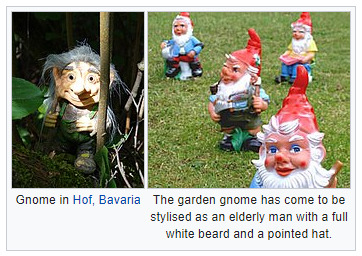
After World War II (with early references, in ironic use, from the late 1930s) the diminutive figurines introduced as lawn ornaments during the 19th century came to be known as garden gnomes. The image of the gnome changed further during the 1960s to 1970s, when the first plastic garden gnomes were manufactured. These gnomes followed the style of the 1937 depiction of the seven dwarves in Snow White and the Seven Dwarfs by Disney. This "Disneyfied" image of the gnome was built upon by the illustrated children's book classic The Secret Book of Gnomes (1976), in the original Dutch Leven en werken van de Kabouter. Garden gnomes share a resemblance to the Scandinavian tomte and nisse, and the Swedish term "tomte" can be translated as "gnome" in English.
Gnome-themed parks

Several gnome themed entertainment parks exist. Notable ones are:
The Gnome Reserve, at West Putford near Bradworthy in North Devon, United Kingdom
Gnomeland, at Watermouth Castle in Berrynarbor, North Devon, United Kingdom
Gnome Magic Garden, at Colchester, United Kingdom
The Gnome Village, at Efteling theme park in Kaatsheuvel, Netherlands
Zwergen-Park Trusetal, in Trusetal, Germany
Garden Gnome Liberationists
Garden gnome liberationists such as the Gnome Liberation Front were introduced in France in 1997. They claim that Garden Gnomes deserve the same freedom that any other living creature would have. They are noted to have stolen hundreds of gnomes.
Gnome parades
Gnome parades are held annually at Atlanta's Inman Park Festival. Numerous one-off gnome parades have been held, including in Savannah, Georgia (April 2012) and Cleveland, Ohio (May 2011).
Metaphorical uses
The expression "Gnomes of Zürich", Swiss bankers pictured as diminutive creatures hoarding gold in subterranean vaults, was derived from a speech in 1956 by Harold Wilson, and gained currency in the 1960s (OED notes the New Statesman issue of 27 November 1964 as earliest attestation).
Architect Earl Young built a number of stone houses in Charlevoix, Michigan, that have been referred to as gnome homes.
A user of Wikipedia or any wiki who makes useful incremental edits without clamouring for attention is called a WikiGnome.
https://en.wikipedia.org/wiki/Gnome
Welp that is all for this Wiki gnome article but there are plenty more!!! Thank you Wiki!!
#gnomelove#gnomegirlgabby#gardengnomes#gnomes#WikiGnomes#GnomeArticle#GnomeHistory#GnomeGames#GnomeFacts#GnomePuns#TravelingGnomes#GnomesPuns#GnomePlaces
1 note
·
View note
Text
Paracelsus, Gnomes, Sylphs and the Rape of the Lock
So the history of Garden Gnomes introduced Paracelsus but didn’t really give you much information on him and his part with gnomes so this article gives a bit more of an explanation. Thank you M.H. Forsyth for writing and posting this article!

Paracelsus was an alchemist, chemist, medic, and all-round egg-head of the sixteenth century. Paracelsus was not his real name of course: that would be ridiculous. His real name was Phillippus Aureolus Theophrastus Bombastus Von Hohenheim. Paracelsus was a moniker he acquired for being the equal of the Roman writer Celsus.
Why shed foolish ink for a chemist? Because, dear reader, Paracelsus invented words. Sometimes he invented words for things that existed: he named zinc zinc because it forms into jagged crystals and zinke is Old High German for sharp. Sometimes, though, he invented names for things that he had merely imagined. And, amazingly, they caught on. Gnomes, for example, are the children of Herr Von Hohenheim's imagination. There were no gnomes until Paracelsus dreamed them. He wrote a (serious) book describing them as being about a foot tall. He contended that just as fish move through water, and we through air, so gnomes can move through solid earth. It seems likely, therefore, that gnome would be a shortening of genomos (earth dweller) and the poor creatures have no etymological truck with gnomic utterances, which are wise. Paracelsus also invented sylphs. As gnomes are earth dwellers, so sylphs are spirits that of the air, and, according to him, are mortal but soulless, like Frenchmen. Nobody's sure where he got the name. It might be something to do with sylvan nymphs, but it might not, and Paracelsus is far too dead to answer questions. Both gnomes and sylphs arrived in our language through the absurd humour of the most quoted poet in history: Alexander Pope. The Rape of the Lock (aside from having a title that makes keys uncomfortable) is a mock epic about a pretty girl having a lock of her hair cut off. Like any good epic it needed a supernatural element, so Pope took up the absurd Paracelsian spirits and made them central to his story. Pope explains that sylphs are the spirits of women so vacuous and vain that they could not properly go to Heaven. Gnomes, on the other hand, are the spirits of prudish women, descended into the earth. The two camps fight futilely and invisibly around the heroine as she suffers her sly tonsure. Pope's work was so popular that the words gained currency in English. Sylphs had, occasionally, been mentioned before by Paracelsian fans, but the English language had never known a gnome before Pope wrote his poem. So, if it weren't for the combined efforts of Pope and Paracelsus, journalists would have no cliché to describe slim girls, and garden gnomes would not exist. Incidentally, garden gnomes commit suicide.
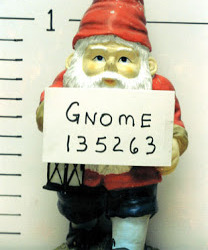
https://blog.inkyfool.com/2010/12/paracelsus-gnomes-sylphs-and-rape-of.html#:~:text=Paracelsus%20also%20invented%20sylphs.,where%20he%20got%20the%20name.&text=Gnomes%2C%20on%20the%20other%20hand,women%2C%20descended%20into%20the%20earth.
Thank you for this article!
Here are my thoughts on the article!
Weird that is how he got his name right?!
Gnomes came from his imagination? hmmm I am not so sure how true that is or if he just gave them their most common name....But I need to read this book he wrote! I need to own it actually!
I really hope gnomes can move through solid Earth! I truly think it they are magical even if they can’t move through solid Earth! Oh wise earth dwellers how I love you!
I had no idea that Gnomes arrived in English due to Alexander Pope and his work The Rape of The Lock... (I hate that name feels awful! But now I feel like I have to read it!) Gnomes were considered spirits of Prudish Women... which to me is odd since most gnomes are male and gnomes came from a deity with a constant erection...
Ok the last sentence ‘Incidentally, garden gnomes commit suicide’ makes no sense to me and needs it’s own article to explain it!!!
#NeededGnomes#GnomeWant#gnomes#gardengnomes#gnomelove#gnomegirlgabby#PopeGnomes#ParacelsusGnomes#AlexanderPopeGnomes#GnomeArticle#GnomeHistory#GnomeFacts#GnomeBooks#GnomeReads
0 notes
Text
History of Garden Gnomes Thoughts
So a few days ago I posted this article by Max! It is pretty lovely but I do have some responses to it since it has made me think pretty hard about a few things in it!
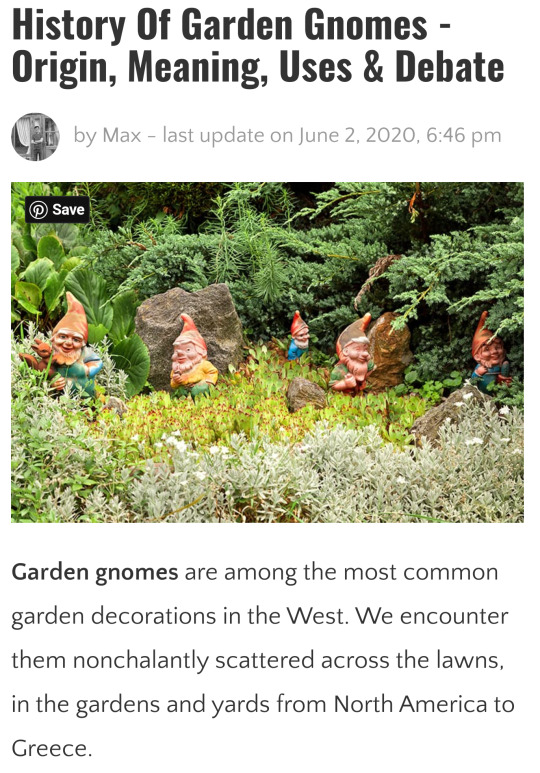
Max did an epic job writing this and doing some serious Gnome research! I will say though that I am not sure why he put them in the West... they are all over literally everywhere! if you keep your eyes peeled you will find them all the time!

I do not like that he says they are just male... that is totally not the case! Female gnomes may be uncommon but they are gnomes! GNOMES DON’T HAVE TO BE MALE!
Gnomes still are good luck charms! Most just got associated to Garden magic instead, not only that Leprechauns exist too and the luck became more their vibe than gnomes but gnomes are definitely lucky little creatures!
Garden Gnomes Meaning
During this section I learned what etymology is, the study of a word’s origin and its changed meaning over time.
Paracelsus gets more explained later but he is used here without explanation as an explanation which bothered me. For reader clarity Paracelsus is a Swiss physician, alchemist, and philosopher. He actually has a lot more importance than they gave him since he is basically the person who made up gnomes! I will post his more in depth crazy article later!
Basically though they believe the word Gnome came out of the Greek language either ‘genomos’ or ‘gnosis’ meaning earth dweller and knowledge. I think personally that a combo of the two is most likely because Gnomes live forever in the Earth really so they are very very knowledgeable about Earthly things.
Petite Gnome In Ancient Rome
The first thing about this section that got to me was the picture... why have a picture without a gnome in it to show that gnomes were in Ancient Rome!
But to be fair I couldn’t find a good picture for it either.... I did find a cool one from Turkey that will be shown off later!
I wish we could see one though and some of the god statues that paved the way for gnome statues! not to mention naughty gnomes since the most common God Priapus had a permanent erection!
Early Modern Period-From Gobbi to Lampy

So now after all that we finally get to find out who Paracelsus is and why he is relevant! So during the Renaissance Era the gnome statues had a spiritual connection as well! Paracelsus is who said they have magical powers (which they do!!!) So he said they were one of the four elementals or nature spirits that were invisible to humans but belonged to the Earth. Gnomes in particular would come out at night to help the plants grow!
They also had another name during the time period of ‘Grotesques’ which at that time was pleonastical because it was very obvious they were not very good looking at time. They were made a ugly petite hunchbacks. Then painted bright colors and called Gobbi which is Italian for hunchback.
Not gong to lie to you all Gobbi sounds a lot like Gabby and I do have the worst posture so this felt like cruel fate!! But will say totally fits and makes a lot of sense to me why I love them soooooo much!
If I was from that time period I would have had the wealthiest family for the amount of gnomes I have!
The popularity of gnomes grew due to all of the folklore and stories with them in it! Epp which makes gnome what they are today!
The First Garden Gnome
The iconic red hat gnome came form a sculptor named Phillip Griebel from Germany!! I love love love that his name is Griebel because it is real close to me true name Gabrielle! I just feel like it was meant to be! I was always supposed to be with the gnomes! Can you believe all these years later his factory still is there and producing gnomes?!
So a while later Sir Charles Isham showed up and brought Griebel’s gnomes over to England! He was believed to start the tradition of Garden Gnomes in the United Kingdom! Gnomes became nicknamed Lampy because Lamport Hall is what made them famous! There is another article of this coming later ;) One still exists and is being preserved at the family residence!
So fun fact one of my sorority sisters is an Isham! She also saved and preserved some of my gnomes from frat boys so I think it was another meant to be moment! Isham helps ‘Gobbi’ Griebel!
The 20th Century- Intermittent Rise And Fall Of Gnome
So I totally get the less money less gnomes thing but I never remotely thought about how gnomes would be impacted by war so that was an eye opening moment.
Snow White and the 7 Dwarfs restoring the glory of the garden gnome got to me... awww no way that happened!!! DRAWFS ARE NOT GNOMES! GNOMES ARE NOT DRAWFS! but I kept reading trying to see Max’s logic.... BECAUSE THEY LOOK SIMILAR!? WHAT!?!?!? Oh I can not get on board with the logic here! I think that many other things helped them out way more but hey not my article!
But seriously why that picture? It is not very snow white... guess it is somewhat gnomie...
I personally am so glad gnomes went to mass production or I would not be able to have a lot! I know that the quality is different but I do not think it is lesser and having gnomes of all sorts is so much more of a blessing than before!! Not less artistic either it is just a different artistic expression! The fall from being only for the wealthy is the best thing that could have ever happened to gnomes!
The Traveling Gnome Prank
Since this happens to me a lot I have a bit of bad vibes! I need to find these pictures of the Antarctica gnome travels that started it all!
Garden Gnome Liberation Front deserves there own posts for sure and will get it but i have a serious love hate with them.... but gnomes do deserve travel freedom! I will say I need more of the epic pictures of gnomes with landmarks!
I have never got one of gnomes back with a travel diary but they really should be! It would make their absence bearable for me!
Amelie is a great movie with one of the cutest gnomes I have ever seen but I will say I hate that it encourages people to take my gnomes on adventures without me!
Gnomes' Red Cap
The Phrygain Cap is the most known thing about a Garden Gnome! I did not know that a gnomes hat had a specific name before this article so I thought it was an awesome fun fact! Really the hat had a whole different vibe before the gnome got to it! But it does make the liberation of garden gnomes and giving them freedom make a lot more sense because those hats used to be the symbolization of freedom and is still worn by nation symbols of France today!
Making of Garden Gnomes
Once again why pick a picture without a gnome in it? I’m sure there are a few of someone out there sculpting a gnome....
Also terracotta clay gnomes are the cutest but also the worst because they break sooooo easily!!! I actually have one I have to fix :(
I need to find all these tutorials and try them honestly!
Types of Garden Gnomes
I am so so glad he amends the male part of garden gnome here and includes females and the babies! Gnome families are real!
Can we just say gnomes are branching out into doing more things of modern culture like playing with a cell phone or being a scientist!
Uses of Gnomes In The Garden
Now the box he puts gnomes in here is not ok to me... they can go literally anywhere and everywhere! Plus they come in so many different forms! Like necklaces, shirts, sheets, the kitchen!!! ANYWHERE! There is a gnome for that I swear!
Gnomes, from Gardening to Popular Culture
So now he kind of shares some gnomes that are not meant to be lawn care takers... once again GNOMES ARE NOT DRAWFS!
I have to admit I am glad the operating system is called GNOME but I hate when I search gnome and only that jazz pops up!
Social Deomcratic Party of Austria used gnomes for marketing and a post of this will come later because I didn’t even know that existed until this article!
A post of gnomes in the mentioned novels will come too because I need to see the reference of these in some of them... I have no idea where the gnomes are!
Travelocity thank you for using a gnome and its cool pictures but it encourages people to take mine toooo much! Plus my Travelocity gnome named Gnomad has never been returned! A post of their twitter is needed though!
I need to check out the George Harrison album with gnomes... another post that will appear!
Gnomeo and Juliet and Sherlock Gnomes are so amazing I hope they make a thrid! Please Elton John Please!
A post on all the festivals around the world that have gnomes will have to come! I need to know where all of these are!!!!
Truly this portion of the article has made it so I have to go down the well and learn more about these gnome appearances!
Garden Gnome Aesthetical Debate
Why is there a picture without gnomes in it?!?! Seriously they were jsut let in so they better be int he picture!!!
2013!!!! 2013!!! The gnomes were just accepted in 2013.... that is crazy to me! I am so glad they are allowed now! Next is to get rid of the gnomophobes and garden snobs!!!
Conclusion
Garden Gnomes are just a big part of life and if you say otherwise you aren’t using your eyes! I don’t think they are a stereotype either!!! or a sweet cliche!!
Yes I do have garden gnomes in the garden but I don’t really have a garden...
Gnomes are Beautiful artistry and the best creatures on the planet really! If you think they are expressions of bad taste we can’t be friends!!
YESSSSSSS GNOMES ARE JUST SOOOOOO CUTE!
I just did a whole response to your article so I will skip writing in the comments :P

Welp that concludes my thought on this article and it taught me a lot and gave me a lot of other gnomes to look into! I hope you feel the need to check some of these gnomes out as well!
https://www.greenandvibrant.com/history-of-garden-gnomes
#GnomeResponse#GnomePun#gardengnomes#gnomes#gnomelove#gnomegirlgabby#GnomeWant#NeededGnomes#GnomeArticle#GreenAndVibrantGnomes#MaxGnomes#GnomeFacts#GnomeHistory#GnomeThoughts#GobbiGnomes#RedHatGnomes#TravelocityGnomes#gnomeo and juliet#SherlockGnomes#gnome chompski
0 notes
Text
So my friend sent me this article written by Allison Meier and it tripped me out! It is titled 'Before The Garden Gnome, the ornamental Hermit: A Real Person Paid to Dress Like A Druid' really made me wonder how they drew this connection... The dunce hats? I don't gnome honestly but I can't get over the not allowed to cut or maintain hair or nails at all....
Below is the article!

WHILE SOME GARDENERS MIGHT NOW throw in a gnome statue among their flowers and shrubberies, back in the 18th century wealthy estate owners were hiring real people to dress as druids, grow their hair long, and not wash for years. These hired hermits would lodge in shacks, caves, and other hermitages constructed in a rustic manner in rambling gardens. It was a practice mostly found in England, although it made it up to Scotland and over to Ireland as well.
Gordon Campbell, a Professor of Renaissance Studies at the University of Leicester, recently published The Hermit in the Garden: From Imperial Rome to Ornamental Gnome with Oxford University Press. It’s the first book to delve into the history of the ornamental hermit in Georgian England. As Campbell explains in this video for the book:
“Recruiting a hermit wasn’t always easy. Sometimes they were agricultural workers, and they were dressed in a costume, often in a druid’s costume. There was no agreement on how druids dressed, but in some cases they wore what we would call a dunce’s cap. It’s a most peculiar phenomenon, and understanding it is one of the reasons why I have written this book.”
How the live-in hermit came to be a fashionable touch to a splendid garden goes back to the Roman emperor Hadrian with his villa at Tivoli, which included a small lake with a structure in it built for one person to retreat. When the ruins of this early hermitage were unearthed in the 16th century, it was suggested that Pope Pius IV build one for himself, which he did at the Casina Pio IV. Yet from here it gradually verged away from religious devotees isolating themselves for spiritual reflection to hermitting being an 18th century profession for those willing to put up with the stipulations.
As Campbell cites from an advertisement referenced in Sir William Gell’s A Tour in the Lakes Made in 1797, ”the hermit is never to leave the place, or hold conversation with anyone for seven years during which he is neither to wash himself or cleanse himself in any way whatever, but is to let his hair and nails both on hands and feet, grow as long as nature will permit them.”


Others asked that their hermits not wear shoes or even to entertain party guests with personalized poetry or the serving of wine. It might seem like a whimsical garden feature, but in fact it was all about that most celebrated of Georgian England emotions: melancholy. Introspection and a somberness of spirit were prized among the elite, and the roles they asked their hermits to play embodied this. A 1784 guide to the Hawkstone estate in Shropshire belonging to Sir Richard Hill describes its resident hermit:
“You pull a bell, and gain admittance. The hermit is generally in a sitting posture, with a table before him, on which is a skull, the emblem of mortality, an hour-glass, a book and a pair of spectacles. The venerable bare-footed Father, whose name is Francis (if awake) always rises up at the approach of strangers. He seems about 90 years of age, yet has all his sense to admiration. He is tolerably conversant, and far from being unpolite.”

At other hours, the Hawkstone hermit was replaced with a mannequin, or perhaps, Campbell speculates, an automaton. Some estate owners who couldn’t afford, or did not want, a real live hermit sometimes set up the hermitage as if its resident had just left. Others used the hermitages themselves.
The ornamental hermit vanished at the end of the 18th century. In The Hermit in the Garden, Campbell chronicles the remains in a “catalogue of hermitages,” listing whether they are destroyed, extant, or never built at all. However, the humble hermit may not have left us entirely. As Campbell argues, “the garden hermit evolved from the antiquarian druid and eventually declined into the garden gnome.”

So ya what do you think? Because I don't get it and I am quite offended by 'declined into the Garden Gnome' it definitely should be 'evolved into the incredible garden gnome we know today!'
Thank you to Atlas Obscura for this article and food for thought...
#gnomelove#gnomes#gnomegirlgabby#gardengnomes#gnomesgnomesgnomes#gnomewant#GnomeHistory#OddGnomeHats
0 notes
Text
Under Water Garden Gnomes Tea Party!
This is an article on Gnome-zone.com! https://gnome-zone.com/204-2/
https://nationalparktraveller.com/underwater-garden-gnomes-tea-party/

The wild scenery and 2,000 foot drop of “The Screes” into England’s deepest lake is the last place you would expect to find a garden tea party of gnomes. Wastwater, in the western part of the Lake District National Park, is the deepest lake in England at 79 metres (258 feet). The Wasdale valley, home to Wastwater, is a glacially ‘over-deepened’ valley and surrounded by some of the highest mountains in England.

Yet under the surface, far removed from the safety of neat lawn edges and squeaky clean garden beds, there are garden gnomes. Originating from Germany in the 19th century, the “garden dwarf” was produced for the purpose of ornamentation and protection from evil sorcery. An eerie twist of fate for these little chaps when you consider the wild surroundings … or is it just a bit of fun? This is a question for the diving community, amongst whom Wastwater is very popular diving location and the existence of these gnomes is well known. Police divers in the past have removed them, in fear of luring inexperienced divers, but the gnomes keep coming back. They are still there and according to the Kendal and Lakes Sub Aqua Club the garden gnomes are a bit of fun providing divers with something to look at rather than just mud. It is said that Wastwater is clearer at 50m (165ft) than Windermere is at 10m (30ft) and so an ideal site for these deep water sites.
Under Pressure
Police say divers should not put themselves at unnecessary risk looking for gnomes in Wastwater. Wastwater is three miles long, half a mile wide and about 80m deep, the deepest in the Lake District. The water is very cold and puts extra pressure on the body. The very clear water can give a false sense of security. A spokesperson from the Sub-Aqua Association warned that you have to be an experienced diver with all the necessary safety precautions to go deep water diving in Wastwater. For more information visit: BBC article in 2007 BBC article in 2012 Kendal and Lakes Sub Aqua Club Penrith Divers

Is that so cool! This would be the biggest treat ever diving if you ask me!! Thank you to whomever put them there!
#gnomes#gardengnomes#gnomelove#gnomegirlgabby#DivingGnome#WastwaterGnomes#GnomeHistory#GnomeArticle#GnomeTeaParty#TheGnomeZone.Com#nationalParkTravelerGnomes
0 notes